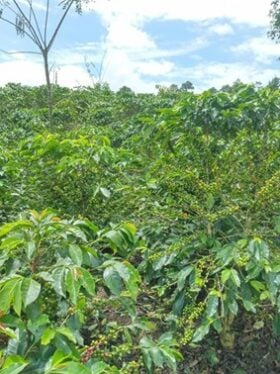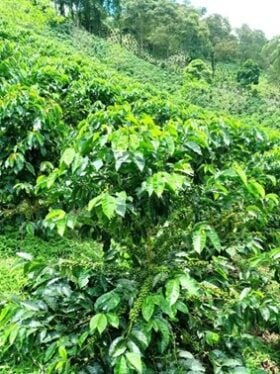Growing Coffee
crop nutrition advice
Everything you need to know about coffee fertilisation, best practice, suitable products, field trials and more.
Advice for growing coffee (Coffea arabica)
-
Coffee performs better in soils with a pH between 5.5 and 6.5.
-
In soils with low pH (below 5) high aluminium concentrations are likely the most important limiting yield factor. Additionally at these pH levels phosphorus, bases, and micronutrient contents might be low leading to deficiency symptoms.
-
Main arabica coffee regions are found in medium to high altitudes from 800 to 2000 masl. Higher altitudes are associated with better cup quality. Robusta coffee grows well at lower altitudes and is associated with lower cup quality than arabica varieties.
-
Optimum vegetative growth occurs when the air temperature is between 18–25ºC.
-
Coffee crops require hydric stress to initiate blooming. Longer, dry periods produce higher bloom peaks and harvest accumulations.

Coffee at maturation phase

Red coffee beans before the harvest
Nutrient requirements
Estimated nutrient uptake (kg/t):
| N | P2O5 | K2O | MgO | SO3 | CaO | |
|---|---|---|---|---|---|---|
| Green coffee beans | 31 | 5.2 | 44.3 | 3.8 | 3.0 | 6.0 |
Source: Manual Cafetero, 2013
Dynamics of nutrient uptake over a coffee crop season
Charts show the accumulated amount of fruit NPK after blooming peak at four locations in Colombia
Role of nutrients
| Key parameter | N | P2O5 | K2O | MgO | SO3 | CaO |
|---|---|---|---|---|---|---|
| Plant Growth | ++ | + | ++ | + | + | + |
| Yield | ++ | + | ++ | + | + | + |
| Fruit quality | +/- | ++ | +/- | ++ | ||
| Chlorophyll | + | ++ | ++ | |||
| Root and leaf development | +/- | ++ | ++ | |||
| Dry matter content | + | + | + | + | + | + |
Adapted from: FAO – Arabica coffee manual for Lao-PDR
Coffee fertilisation recommendations
Coffee fertilisation must be based on crop stage and following the 4R stewardship: Right dose, Right source, Right moment, and Right place.
Stage 1: Seeding
For this stage, lasting 4 to 6 months, it is important to have a well-conditioned substrate in the bags. The use of up to 50% of composted manure, organic materials, or fine sand mixed with soil plus the addition of phosphorus, calcium, magnesium, and micronutrients will produce vigorous plants for establishment.
Stage 2: Establishment
After being planted in fields, coffee plants require from 12 to 18 months of growth to get established, before the first bloom. For this stage, coffee fertilisation must be applied with an individual dose per plant, based on soil chemical analyses and plant requirements. Fertilisation programs vary widely between countries, and even within the same country, due to soil, climate, variety, plant density and management practice differences.
Stage 3: Productive
After coffee crops reach the blooming peak, part of the fertilisation strategy will be focused on bean filling. Applications can be made from 2 to 4 times a year, depending on rainy periods.
Coffee plantations showing the effect of applying balanced nutrition
 Only NPK |
 NPK+Ca+Mg+S+B+Zn |
Q&A
Here are some frequently asked questions we received from farmers regarding coffee.
-
As all crops, coffee requires the 14 essential nutrients which must be always supplied, particularly if soils have low nutrient contents. During harvest time or the productive stage, the nutrient requirements follow this order: K>N>Ca>P>Mg>S>micronutrients
-
Depending on the type and amount of lime materials applied, it is possible to supply more than 50% of Ca and Mg requirements. However, it is also necessary to apply more soluble sources of Ca to compensate for coffee’s higher requirements during the first 60 days after blooming. Polysulphate fertiliser has demonstrated itself to be an important soluble source of Ca when applied at least one month before blooming peaks.
-
Coffee has demonstrated a high tolerance to soil Aluminium (Al) contents over 1 cmol/kg. However in soils with low base saturation, Al saturation must be lower than 25% to avoid a negative effect on growth and yield.



